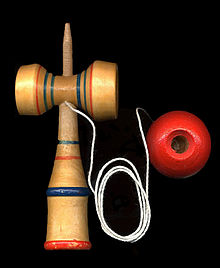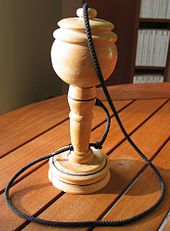Kendama: Difference between revisions
m Reverted good faith edits by 75.149.162.69 talk: Test edits (HG 3) |
|||
| Line 79: | Line 79: | ||
* '''Downspike:'''Swing the ball, stab downwards at the ball and land it on spike. |
* '''Downspike:'''Swing the ball, stab downwards at the ball and land it on spike. |
||
* Swing Bird Swing onto bird |
* Swing Bird Swing onto bird |
||
* '''Seat Belt''' land a stalled spike |
|||
==References== |
==References== |
||
Revision as of 17:20, 13 May 2014

A kendama (けん玉, also written as 剣玉 and 拳玉) is a traditional Japanese toy which consists of three wooden cups of different sizes placed on the center of a wooden spike, with a smaller cup at the spike's base and a ball connected by a string to the center piece. In English, kendama may be referred to as ring and pin and bears similarities to the classic test game, similar to the Hispanic world toy known as boliche or balero. The principle of these toys are the same: catching one object with another, where both are joined by a string.
Structure and terminology

The main body of the kendama is called the ken (剣). At one end of the ken is a spike - in Japanese kensaki (剣先) -used to perform a basic trick whereby one flicks the kendama with one hand and 'spikes' the ball on the point. At the other end of the ken is the grip, which is tailored to prevent the kendama from flying out of one's hand. This is called the slip stop, or in Japanese, suberidome (すべり止め). The ball—called a tama (玉)—features a hole drilled partway through, enabling it to be speared on the spike. The ball is connected to the ken with a length of string measuring approximately forty centimetres (sixteen inches).[1] The two extending sides of the kendama are concave cups; one is smaller than the other. The larger cup is called the ōzara (大皿, lit. "big cup") and the smaller cup is called the kozara (小皿, lit. "small cup"). The crosspiece which joins the cups to the ken is called the sarado (さらど). There is another, smaller cup, called the chūzara (中皿, lit. "center cup") at the bottom of the ken.
Origins and precursors

The origins of the game are obscure. It can be argued that the vagueness of kendama's origins is due to a common necessity in all hunting cultures for early childhood training of hand-eye co-ordination. It is speculated that the toy may have been invented independently in multiple places, or spread via international commerce.
It is known in places as diverse as the Arctic, France, and Peru.
The French game bilboquet, a forerunner of the kendama, was played as early as the 16th century.[2] The game was popular in the royal courts of Europe, where players caught a swinging ball in a cup at the end of the handle. In North America, the game was both a child's toy and a gambling mechanism for adults, and involved catching a ring rather than a ball. In some native American tribes it was even a courtship device, where suitors would challenge the objects of their interest to a polite game of ring and pin. The Mohave variant of the game included up to 17 extra rings attached to the cord, and game scoring involved differing point values assigned to different rings.[2] Other variants include those played by the Inuit of what is now Labrador, with a rabbit's skull in place of the ball, with extra holes bored into it, which had to be caught on the handle like a skewer; and those that used balls of grass or animal hair.[2] This game was also popular in England during the early 19th century, as Jane Austen is reputed to have excelled while entertaining her brother's son in a game called bilbocatch.
Japanese Past
The Kendama arrived in Japan via the Silk Road in around 1777, at which point Nagasaki was the only port open to foreign trade. Reportedly, Kendama was initially a sort of adult's drinking game — a player who made a mistake was forced to drink more.[1]
Japan's Ministry of Education told a report which mentioned Kendama, suggesting that the game had by then been adopted by Japanese children.
In the early 20th century, the toy had two side cups and was called a jitsugetsu ball (日月ボール). This translates to 'sun and moon ball', named so because of the ball's representation of the sun and the cups' likeness to the crescent moon.[3]
In 1919, Hamaji Egusa applied for a patent on the 'ball and cup' style toy and it was awarded in 1920. The size and proportions of the toy were later altered. Hatsukaichi City in Hiroshima Prefecture is considered to be the birthplace of the modern Japanese Kendama.[4] The current competition design descends from Issei Fujiwara's model, which featured string holes in the crosspiece. Little deviation has been made from his basic design, with the exception of the ken becoming more rounded to reduce wood chipping. It was also Fujiwara who established the Japan Kendama Association, which established the rules for play, the grading system now in use, and organised competition. In order to ensure that the toy was suitable for use in competition, the JKA also standardised Kendama itself.
Today, Kendama is popular in many parts of the world. Kendama is, of course, particularly well loved in Japan, where national tournaments are held and Japanese employers recognise applicants who have attained the higher dan rankings as "persistent, patient and determined potential employees".
Rules
To play with a kendama, one holds the toy, and pulls the ball upward so that it may either be caught in one of the cups or land with the hole on the spike. More advanced tricks include sequential balances, juggles, and catches. Many tricks involving the kendama have yet to be discovered. There are eleven prescribed moves on the kendama trick list for achieving a kyu ranking and several more for a dan ranking. A 10-kyu rating (the lowest beginner grade), for example, is attained by simply catching the ball in the largest cup. A book published by the Japan Kendama Association lists 101 different tricks for the toy and there are supposedly tens of thousands of trick variations. Different stances and grips are required to perform different tricks.
While most people play with kendamas for personal satisfaction, competitions do take place, especially in Japan. Participation in such competitions entails performing lists of tricks in sequence or completing particular tricks repeatedly for as long as possible. Additionally, tricks may be performed head to head with a rival to determine a winner. The first competitor to fail a trick loses.
In the trick moshikame (もしかめ), the ball is juggled between the big cup and the smallest cup at the bottom repeatedly. A Japanese children's song of the same name is often sung to help with timing.
List of tricks
- Around the Block: Big cup-small cup-base cup
- Around the World: Big cup-small cup-base cup-spike
- Frying pan/crossbar: Land ball between sarado and spike
- Slip on Spike: crossbar to sliding spike
- Earth Spin: spike to flip back on spike
- Around Indonesia: Spike- Big Cup- Frying pan/Crossbar- Spike
- Around Japan: big cup-small cup- spike
- Around the Europe: big cup-spike-small cup-spike-base cup-spike
- Around U.S.A: big cup-spike-Earth spin-small cup-spike-Earth spin-base cup-spike-Earth spin
- Around Germany: big cup-base cup-small cup-big cup-base cup
- Bird: balance ball between spike and big cup
- Nightingale: balance ball between spike and small cup
- Midnight/Handlestall: balance ball on the ring of the Ken (under base cup)
- Lighthouse: balance base cup on ball
- Airplane: swing ken to land spike in hole while holding the ball
- Spike: Pull up ball to stab down spike
- Gravity: Big cup, swing kendama over head while keeping the ball in the cup.
- Over The Valley: Bird, Nightingale, spike
- Lunar: Balance on big cup while holding the ball
- Barrel: Balance on small cup while holding the ball
- Solar: big cup to base but hit side of the base cup swinging it all the way around to base cup then spike.
- Stilt: bird while holding the ball.
- Ken Flip: Catch ball on cup, flip kendama in mid-air, and catch ball on any cup, spike, bird etc. (you can use only one hand)
- Whirlwind: Just like Ken Flip, but start by catching on the spike and end with catching it on the spike.
- Acrobatic: Put ball on spike then swing,Catch kendama in the air then land on base cup.
- Orbit: Big cup then toss the ball up while moving the ken around the ball, landing back on the cup.
- Sideways Earth Spin/Mars Spin: Earth Spin, but sideways.
- Jumping Stick: Airplane, then flick the ken, making a back flip motion, landing back in the hole.
- U.F.O: Jumping Stick, but sideways.
- North to South: Spike to base cup.
- Underbird/Deadbird: Balance the ball under the cup (Opposite of bird).
- Stunt Plane: Upside down Airplane
- Spacewalk: Start by holding the ken. Swing it and let it go in a full circle and catch the ball/ken landing on cup/spike.
- Finger Roll: Spin string around finger from ball to ken (Vice versa).
- Hand Roll: Spin string around hand from ball to ken (Vice versa).
- Turntable/Finger Spin: Catch ball on big cup and spin the whole kendama in a 360 on your middle finger as its placed on the bottom of the small cup.
- Zero Gravity: Spike the ball and spike the whole kendama around your finger as the ball is still on spike.
- Border Balance: Balance the spike of the ken on the ball.
- Faster than Gravity: Hold the ken above the ball and pull the ken underneath the ball as fast as you can to spike it without moving the ball. (Typically done while holding the ken above eye level) (Don't bounce the ball nor bend the knees).
- Moonwalk: hold the base cup and swing back, swinging the ball forward, catch the ball and repeat. Then catch the ken landing the ball on any cup.
- Raven/Wingwalker: Balance the ball on the side of the big cup (but not necessarily like a spike
- Downspike:Swing the ball, stab downwards at the ball and land it on spike.
- Swing Bird Swing onto bird
- Seat Belt land a stalled spike
References
- ^ a b http://web-japan.org/kidsweb/virtual/kendama/kendama02.html
- ^ a b c Andrew Leibs (2004). Sports and Games of the Renaissance. Greenwood Publishing Group. pp. 84, 147–148. ISBN 0-313-32772-6.
- ^ http://web-japan.org/kidsweb/virtual/kendama/kendama01.html
- ^ http://www.j-higa.net/culture/43%20kendama/43%20kendama-e.html
